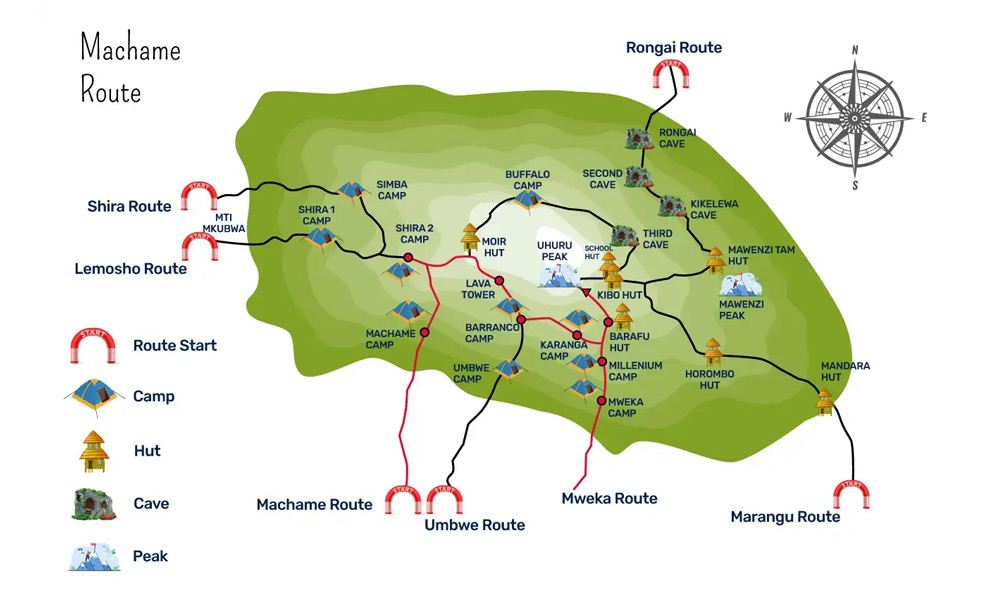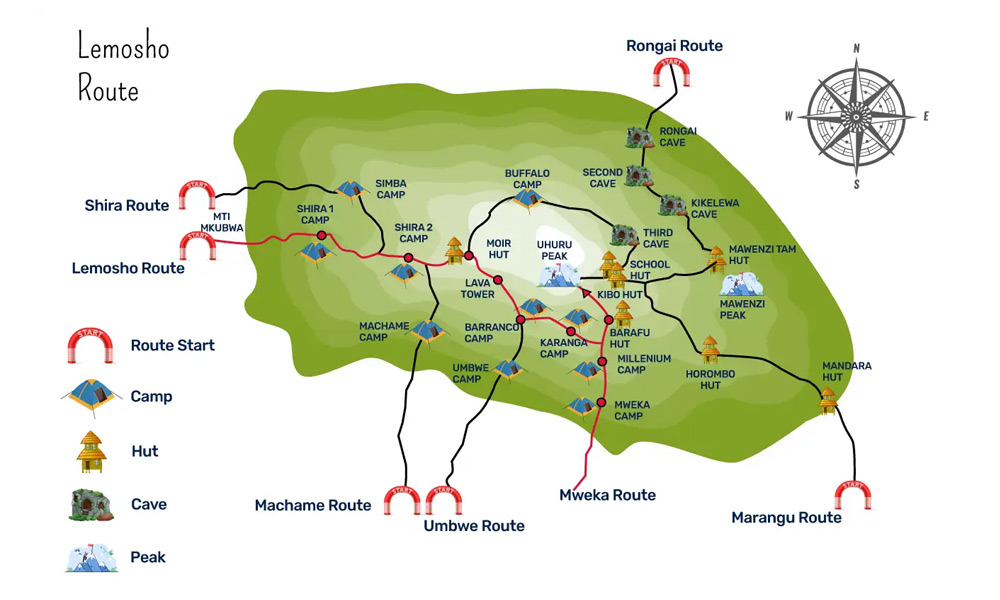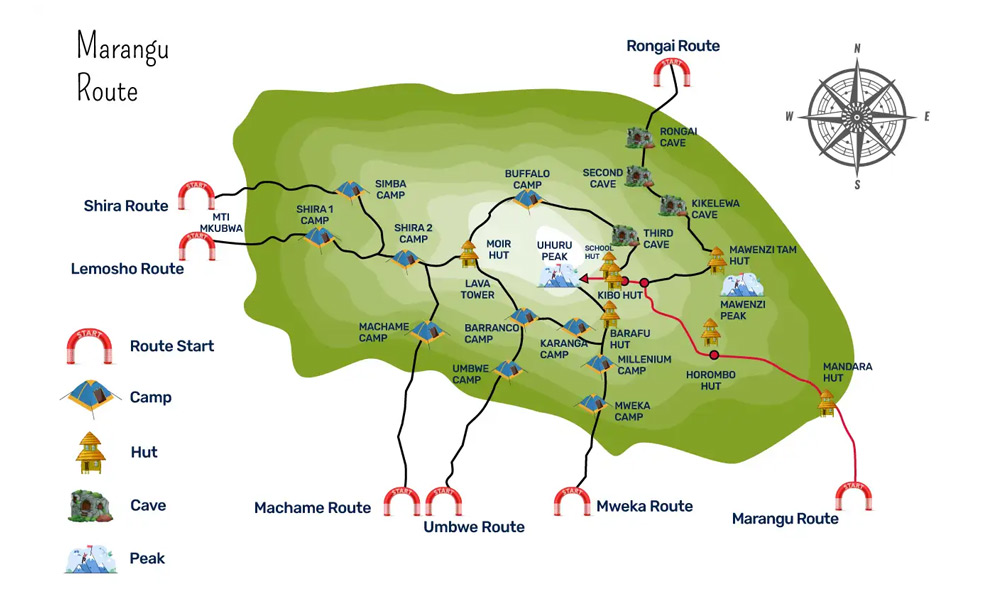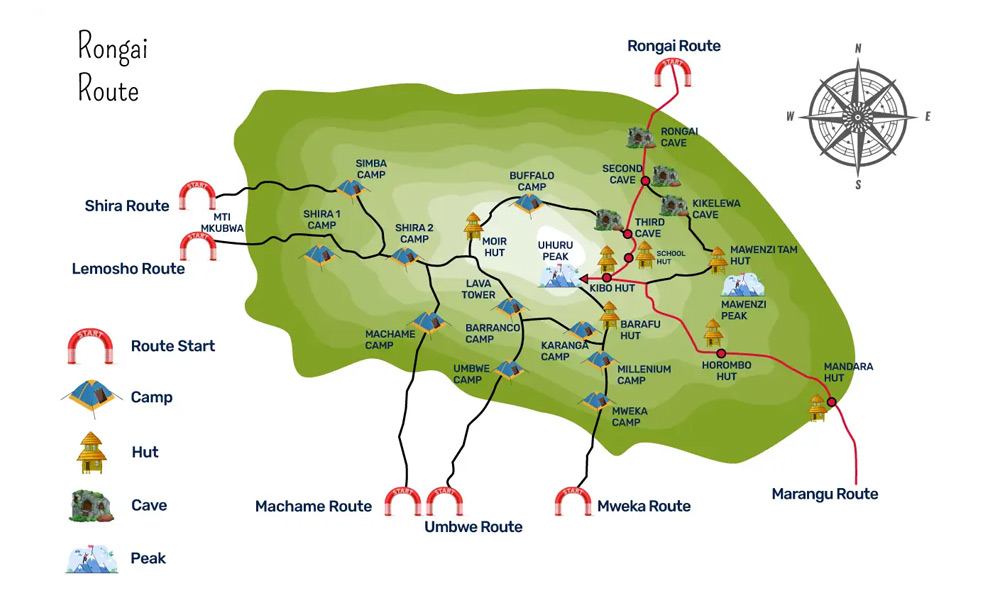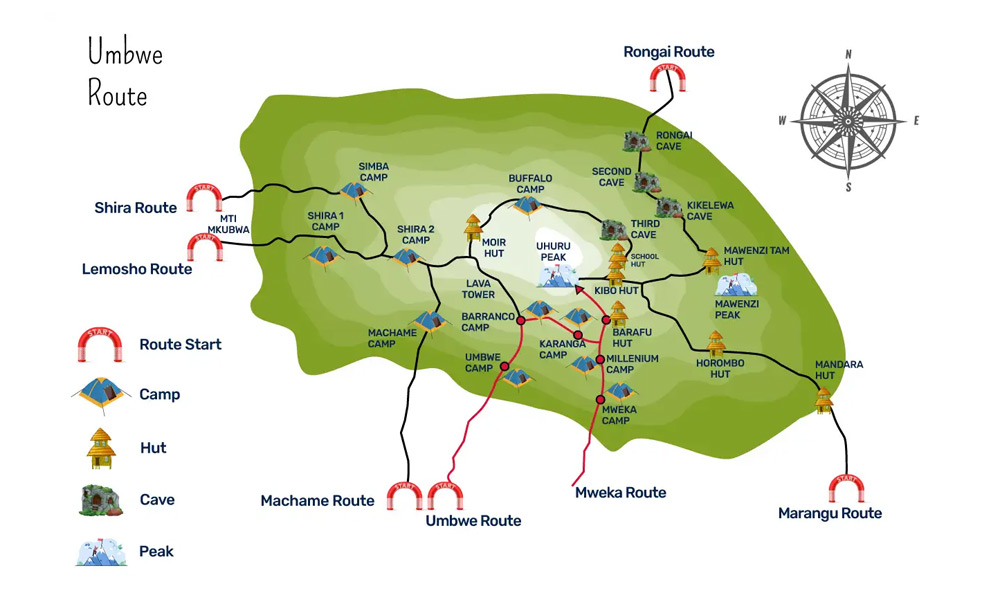
Holidays | Africa | Tanzania | Kilimanjaro | Umbwe Route to Mt Kilimanjaro
Unique Experiences
The Umbwe route is one of the shortest routes to the Southern Glaciers and the Western Breach and its the most challenging route on Mt Kilimanjaro.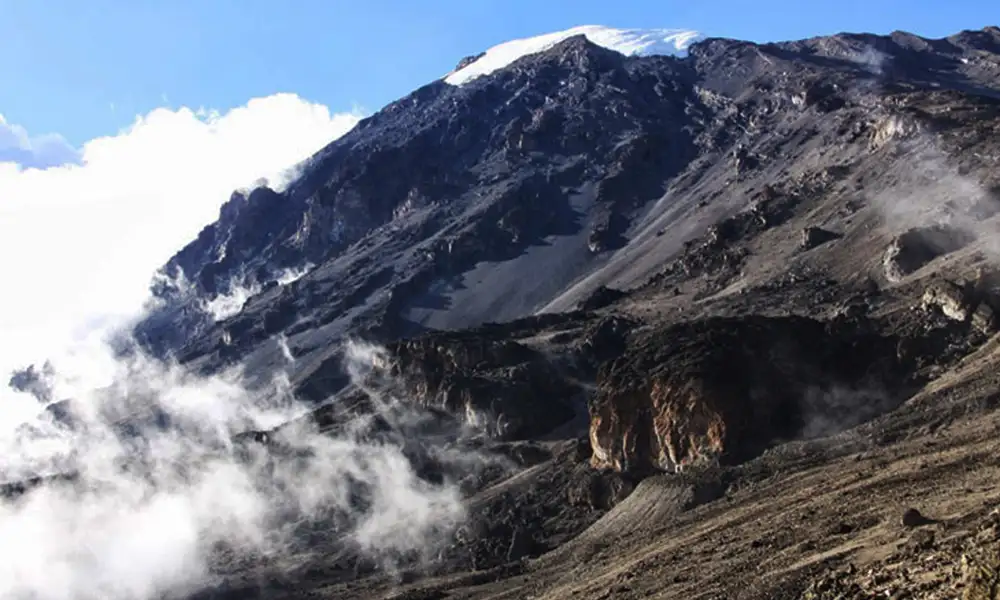

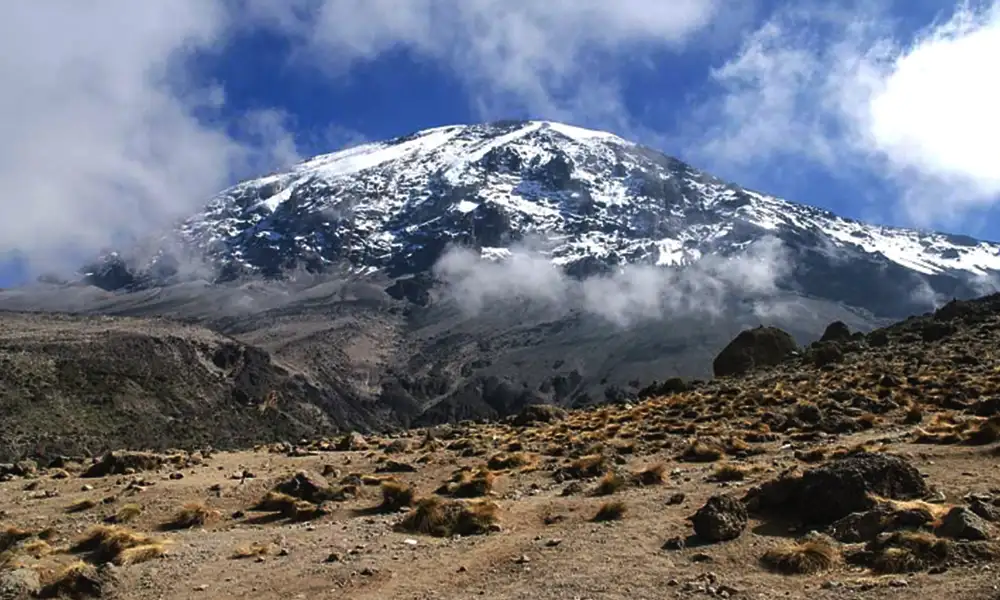
Umbwe Route - 6 days
Umbwe route is one of the shortest routes to the Southern Glaciers and the Western Breach and it’s the most hardest and challenging route on Mount Kilimanjaro. The Umbwe Route is the trail for trekkers looking for a true climbing challenge. It is a quiet, seldom used path that can be very difficult, yet very rewarding at the same time. This is the route to choose if you want to test yourself on the slopes of Mount Kilimanjaro, far from the crowds that are found on the more common trails.
While Umbwe route is a non-technical climb, it does offer steep ascents and requires trekkers to scramble over rocks and tree roots at certain points. It is the hardest and most direct route up the mountain and even features several exposed ridges that are not for the faint of heart. The fitness and stamina of hikers may be tested along the way and it is best for experienced mountain trekkers who are looking for a challenge. Because of it’s steep, direct approach, the success rate on Umbwe route is lower than some of the other routes.
To get the most out of this climb, trekkers are encouraged to be as fit and ready as possible, as this is a steady march uphill for the first few days, which is contrast to some of the other routes that make slow, steady ascents or wander up and down to aid in acclimatization.
That said, the intense challenge of trekking the Umbwe Route is made up for by the spectacular views. At times, there are stunning vistas to be seen to both the left and the right as trekkers make their way up the trail. In fact, the early days of this path have arguably the best views of any part of the mountain, save perhaps the summit itself.
Umbwe also happens to be one of the quietest routes up Mount Kilimanjaro too. Because of its reputation as a difficult climb, very few people actually walk this trail, leaving it open and relatively untouched. This helps to give trekkers the feeling that they are the only ones on the mountain until the route merges with Machame route near the Barranco Camp a few days into the hike. From there, it follows the familiar Southern Circuit below the Southern Ice Field before turning up towards the summit from Barafu Camp. As with most Kilimanjaro climbs, the descent is made along the Mweka Route.
If you're looking for the absolutely best views on the way up Mount Kilimanjaro, and you enjoy testing yourself in the wilderness, Umbwe route will provide you with everything you seek, and then some. It is the closest thing you’ll find to a true mountaineering expedition on Kilimanjaro. GlobalXplorers offers Umbwe as a 6 or 7 day group or private climb. The seven day variation adds an acclimatization day on day 3 at Barranco Camp.
ITINERARY
Elevation (m): 1600m to 2900m, Distance: 11km, Time: 6 hours, Habitat : Montane Forest.
Elevation (m): 2940m to 3970m, Distance: 6km, Time: 4-5 hours, Habitat: Montane Forest.
We leave camp and shortly afterwards the forests end. We can see the sheer wall of the Western Breach appearing and disappearing as the afternoon mists roll up the Great Barranco. We will camp at Barranco camp tonight.
Elevation (m): 3950m to 3930m, Distance: 7 km, Hiking Time: 4 hours, Habitat: Alpine Desert.
Today starts with a short, but fun, scramble, to the top of the Great Barranco Wall. We then traverse over scree to the Karanga Valley (3930m) beneath the icefalls of the Heim, Kersten and Decken Glaciers. We will stay overnight at Karanga campsite.
Elevation (m): 3930m to 4600m, Distance: 6kms, Hiking Time: 3 hours, Habitat: Alpine Desert.
We leave Karanga campsite behind to meet the junction connecting with the Mweka descent Trail. From here we continue up to the Barafu Hut. You have now completed the Southern Circuit, which offers views of the summit from many different angles. At camp, we can rest, enjoy dinner, and prepare for the summit day. The two peaks of Mawenzi and Kibo are to be clearly seen from this position.
Elevation (m): 4600m to 5895m (and down to 3100m), Distance: 7km ascent / 23km descent, Time: 6- 8 hours ascent / 7-8 hours descent, Habitat: Stone scree and ice-capped summit.
You will be woken at 23:30 with some quick tea and biscuits. We start our trek to the summit between the Rebman and Ratzel glaciers. We will head in a north-westerly direction and ascend through heavy scree towards Stella Point on the crater rim. This is the most mentally and physically challenging part of the trek. At Stella Point (5732m), we will stop for a short rest and will be rewarded with the most magnificent sunrise you are ever likely to see (weather permitting). At Uhuru Peak (5895m), we will have reached the highest point on Mount Kilimanjaro and the continent of Africa. It can be very cold at night at these elevations, but it will be quite warm by the end of the hiking day. From the summit, we descend down to the Mweka Hut camp site, via Barafu for lunch. Trekking poles will be needed for the loose gravel going down to Mweka Camp (3100m). Later in the evening, we will enjoy our last dinner on the mountain and a well-earned sleep.
Elevation (m): 3100m to 1800m, Distance: 8 km, Time: 3-4 hours, Habitat: Montane Forest.
We depart after breakfast descending down to the Mweka Park Gate to receive your summit certificates. At lower elevations, it can be wet and muddy. Gaiters and trekking poles will help. Shorts and t-shirts will be suitable (keep rain gear and warmer clothing handy).
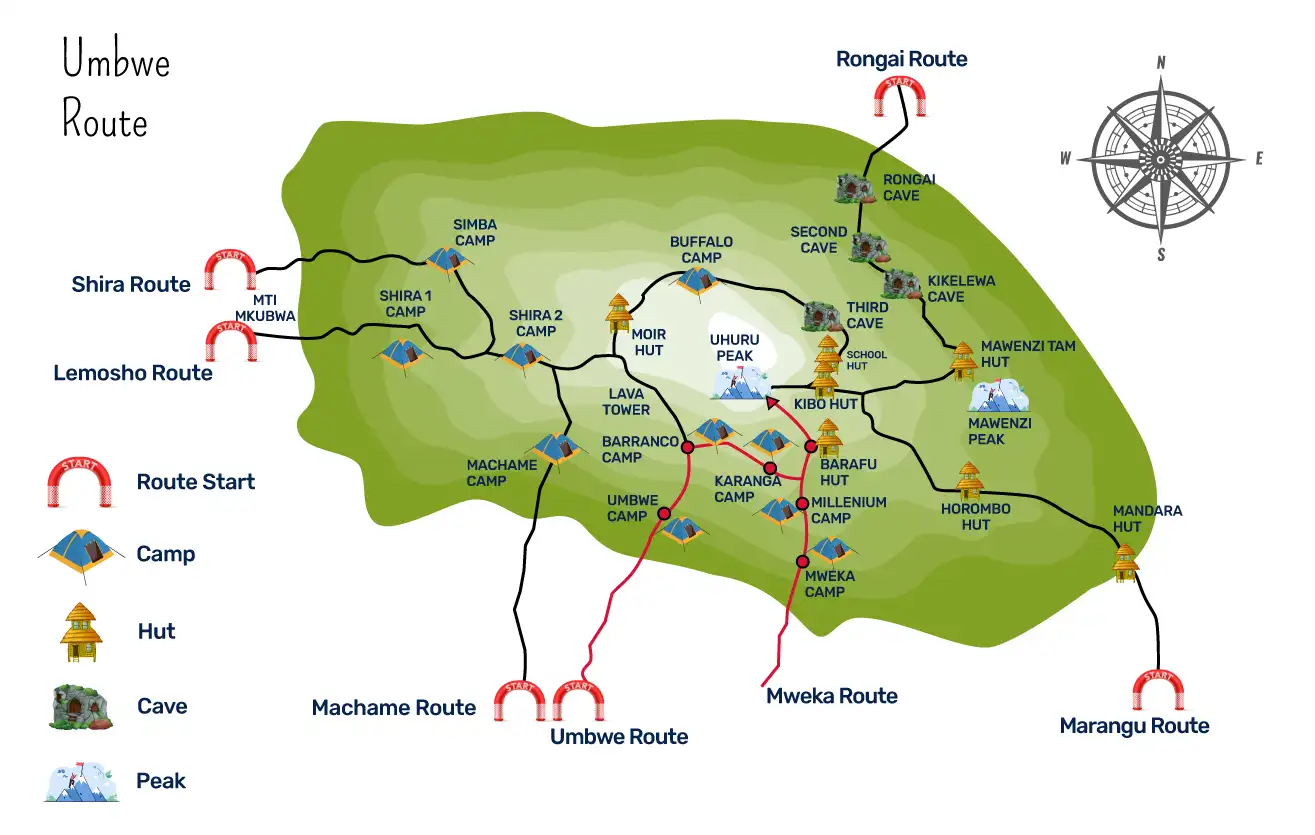
6 Day Umbwe Route Itinerary Overview
Starting from Umbwe Gate to the summit and finish at Mweka GateUMBWE GATE TO UMBWE CAVE CAMP
Elevation (m): 1600m to 2900m, Distance: 11km, Time: 6 hours, Habitat: Montane Forest.
We will register at Umbwe Park Gate before starting our trek. The small winding path leads us up through rainforest and along the Umbwe river. The first night’s camp is at Umbwe Cave Camp, at about 2,900m altitude.

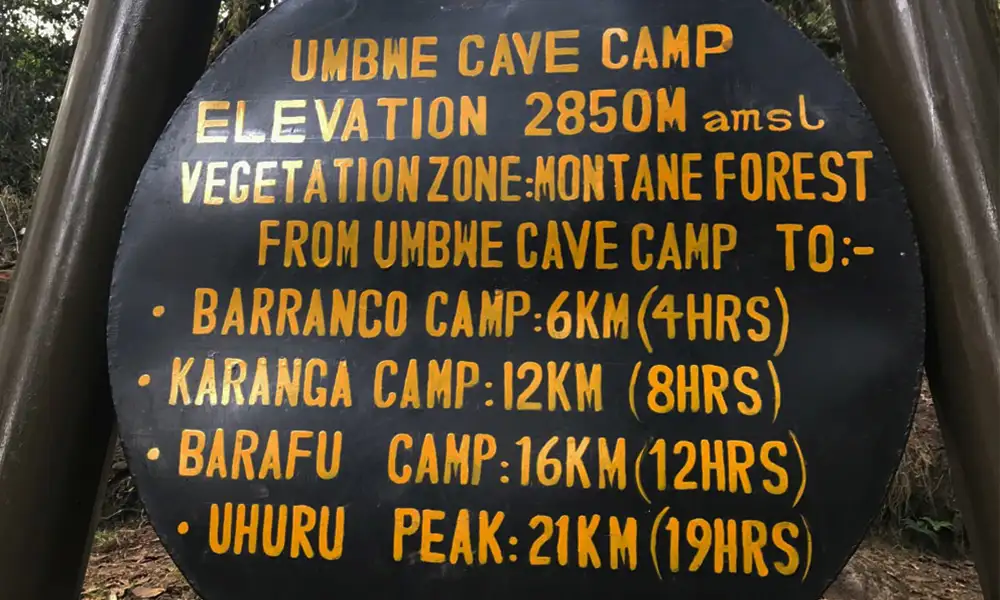
UMBWE CAMP TO BARRANCO CAMP
Elevation (m): 2940m to 3970m, Distance: 6km, Time: 4-5 hours, Habitat: Montane Forest.
We leave camp and shortly afterwards the forests ends. We can see the sheer wall of the Western Breach appearing and disappearing as the afternoon mists roll up the Great Barranco. We will camp at Barranco camp tonight.
BARRANCO CAMP TO KARANGA CAMP
Elevation (m): 3950m to 3930m, Distance: 7 km, Hiking Time: 4 hours, Habitat: Alpine Desert.
Today starts with a short, but fun, scramble, to the top of the Great Barranco Wall. We then traverse overseeing to the Karanga Valley (3930m) beneath the icefalls of the Heim, Kersten and Decken Glaciers. We will stay overnight at Karanga campsite.

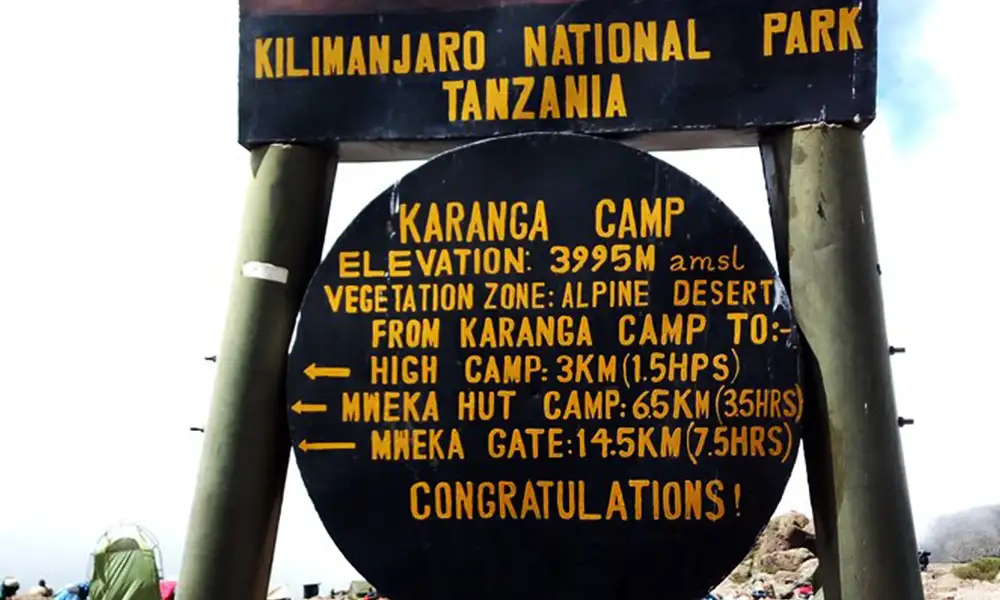
KARANGA CAMP TO BARAFU CAMP
Elevation (m): 3930m to 4600m, Distance: 6kms, Hiking Time: 3 hours, Habitat: Alpine Desert.
We leave Karanga campsite behind to meet the junction connecting with the Mweka descent Trail. From here we continue up to the Barafu Hut. You have now completed the Southern Circuit, which offers views of the summit from many different angles. At camp, we can rest, enjoy dinner, and prepare for the summit day. The two peaks of Mawenzi and Kibo are to be clearly seen from this position.
BARAFU CAMP TO SUMMIT TO MWEKA HUT
Elevation (m): 4600m to 5895m (and down to 3100m), Distance: 7km ascent / 23km descent , Time:6- 8 hours ascent / 7-8 hours descent, Habitat: Stone scree and ice-capped summit.
You will be woken at 23:30 with some quick tea and biscuits. We start our trek to the summit between the Rebman and Ratzel glaciers. We will head in a north-westerly direction and ascend through heavy scree towards Stella Point on the crater rim. This is the most mentally and physically challenging part of the trek. At Stella Point (5732m), we will stop for a short rest and will be rewarded with the most magnificent sunrise you are ever likely to see (weather permitting). At Uhuru Peak (5895m), we will have reached the highest point on Mount Kilimanjaro and the continent of Africa. It can be very cold at night at these elevations, but it will be quite warm by the end of the hiking day. From the summit, we descend down to the Mweka Hut camp site, via Barafu for lunch. Trekking poles will be needed for the loose gravel going down to Mweka Camp (3100m). Later in the evening, we will enjoy our last dinner on the mountain and a well-earned sleep.
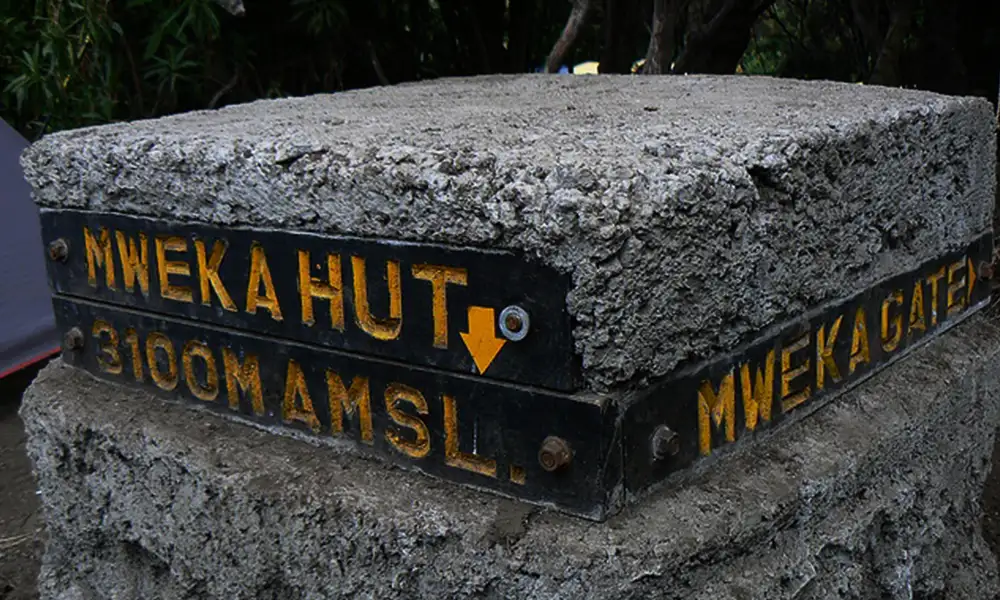
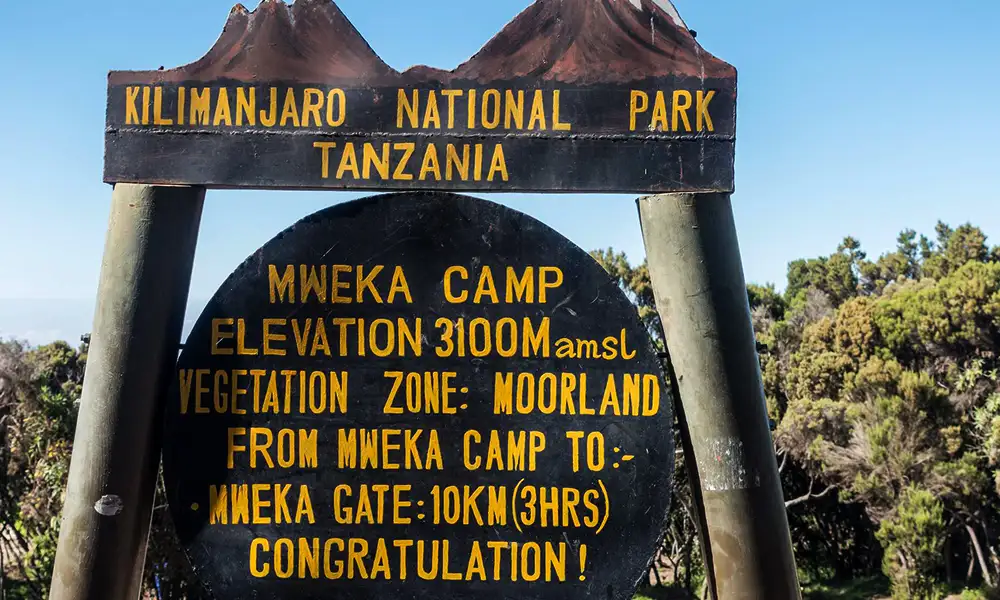
MWEKA CAMP TO HOTEL
Elevation (m): 3100m to 1800m, Distance: 8 km, Time: 3-4 hours, Habitat: Montane Forest.
We depart after breakfast descending down to the Mweka Park Gate to receive your summit certificates. At lower elevations, it can be wet and muddy. Gaiters and trekking poles will help. Shorts and t-shirts will be suitable (keep rain gear and warmer clothing handy).
Frequently asked questions
The questions and answers below are specific to the Umbwe Route.The Umbwe route is one of the shortest routes to the Southern Glaciers and the Western Breach and its the most challenging route on Mt Kilimanjaro. Approaching from the south, the Umbwe route is a short, steep and direct climb. It is probably the most scenic, non-technical route on Kilimanjaro. It is quite taxing, primarily due to the relatively fast ascent to higher altitude, but the rewards are plentiful.
Due to the fast ascension to high altitude, this route does not provide the necessary stages for acclimatization. Although the traffic on this route is very low, the chances of success are also low. Good level of fitness is highly recommended.
The Umbwe Route is one of the shortest routes up Kilimanjaro which has a very poor chance for acclimatization due to it’s steepness and days spent in the mountain. Whilst there are no official statistics, the average success rate across all operators is 70%. However, we have a summit success rate of over 90% for the Umbwe Route!
The first two days of the Umbwe Route trek are through tree plantations and then beautiful and rich rain forest. Before continuing into the steep Western Breach and Arrow’s Glacier path, scramble up to the Reutsch Crater (5,800 meters) where trekkers spend the night near one of Kilimanjaro’s last remaining glaciers, Furtwangler Glacier. From Crater Camp, one can take an optional one hour hike to Reusch Crater, or simply explore the areas around Furtwangler Glacier. Reusch Crater is a magnificent sight. It is almost perfectly circular and the ash pit measures 400 feet (120 m) deep and 1,300 feet (400 m) wide. This is rarely seen by tourists.
Strongly Advised Vaccinations
- Hepatitis A: This can be spread via contaminated food and water.
- Tetanus: Tetanus is often present in the soil, and can contaminate open wounds easily. Tetanus vaccine should be used every ten years if travelling.
- Typhoid: Typhoid can also be spread via contaminated food and water, and poor hygiene.
- Diphtheria: This potentially fatal disease is spread mainly via spit, but occasionally through contact with cuts on the skin.
- Yellow Fever: This can be contracted by being bitten by a contaminated mosquito. This vaccination is not essential if you are arriving directly in Tanzania. You do need it though if you plan to arrive through any country that is subject to yellow fever. Simply stopping over at an airport in an affected country should not require vaccination, but leaving the airport even briefly would make it necessary.
Sometimes Advised Vaccinations
- Hepatitis B: This illness is spread via contact with blood or bodily fluids. It is many, many times more virulent than HIV/AIDS. Some 8% of the population of Tanzania are believed to carry the virus.
- Rabies: Rabies is spread via contact between the saliva of any infected animal and an open wound (including bites, but also licking existing wounds). Rabies is fatal unless treated, and treatment of an unvaccinated rabies patient can be very difficult in many parts of Tanzania.
- Tuberculosis: TB is generally contracted through inhaling airborne sputum.
- Cholera: Cholera is spread via contaminated food and water, and poor hygiene.
- Measles: This disease is spread through inhaling sputum.
Other Mount Kilimanjaro routes
-
Machame Route Kilimanjaro

6 nights / 7 days Climb

- Trek Grading: 5 (Moderate)
- Ages: 10+
- Activity Type : Trek
-
Lemosho Route Kilimanjaro

6 nights / 7 days Climb

- Trek Grading: 5 (Moderate)
- Ages: 10+
- Activity Type : Trek
-
Marangu Route Kilimanjaro

6 nights / 7 days Climb

- Trek Grading: 5 (Moderate)
- Ages: 10+
- Activity Type : Trek
-
Rongai Route Kilimanjaro

6 nights / 7 days Climb

- Trek Grading: 5 (Moderate)
- Ages: 10+
- Activity Type : Trek
-
Northern Circuit Route Kilimanjaro

7 nights / 8 Days

- Trek Grading: 5 (Moderate)
- Ages: 10+
- Activity Type : Trek

